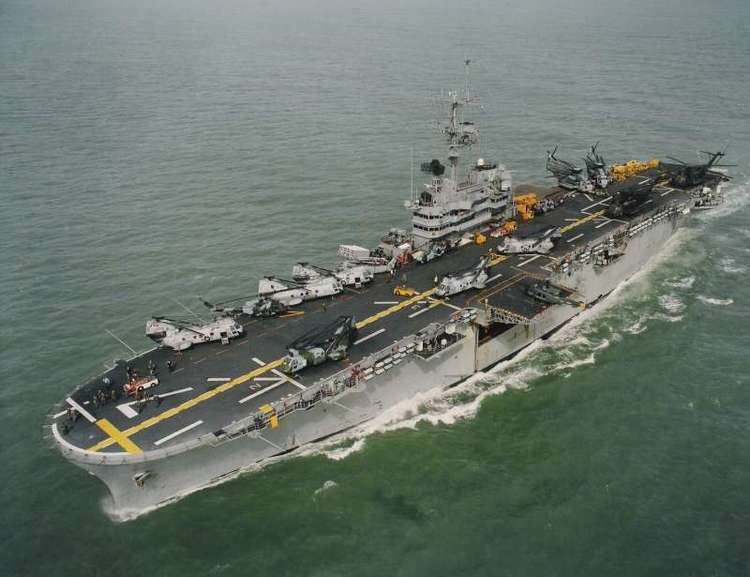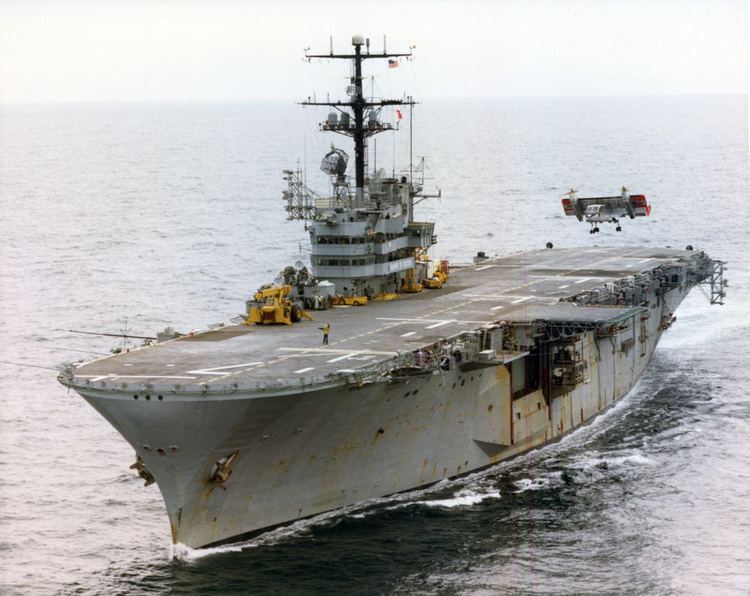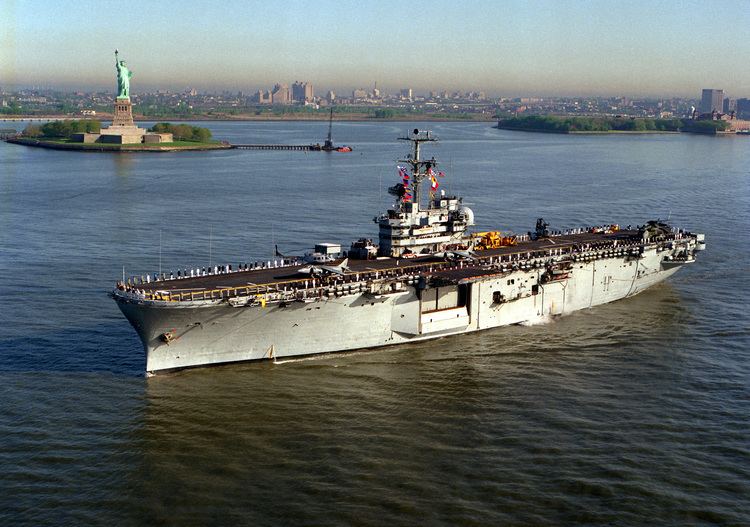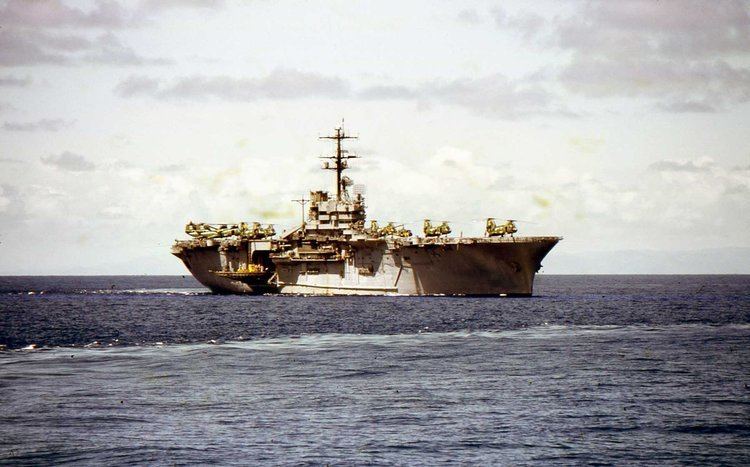Ordered 21 December 1959 Commissioned 20 July 1963 Struck 31 August 1994 Construction started 1 September 1961 Draft 8.2 m | Laid down 1 September 1961 Decommissioned 31 August 1994 Length 184 m Launched 16 March 1963 | |
 | ||
Builder | ||
USS Guadalcanal (LPH-7), the third Iwo Jima-class amphibious assault ship (helicopter), was launched by the Philadelphia Naval Shipyard 16 March 1963, sponsored by Mrs. David Shoup, wife of General Shoup, the former Commandant of the Marine Corps; and commissioned 20 July 1963, Captain Dale K. Peterson in command. It was the second ship in the Navy to bear the name.
Contents

Operational history

Upon completion of sea trials and outfitting, Guadalcanal departed Philadelphia to join the Amphibious Forces, U.S. Atlantic Fleet. One of a new class of ships designed from the keel up to embark, transport, and land assault marines by means of helicopters, she lent new strength and flexibility to amphibious operations. After departing Norfolk 23 October 1963 for six weeks' shakedown training at Guantanamo Bay, Cuba, Guadalcanal steamed to Onslow Beach, North Carolina, 6 December for practice amphibious landings. She then carried on training and readiness operations with the Atlantic Fleet, based in Norfolk until departing for Panama 11 February 1964. Following 2 months on station as flagship for Commander PhibRon 12 with the 12 Marine Expeditionary Unit embarked and ready to land anywhere needed. Guadalcanal entered Philadelphia Naval Shipyard 26 May, but was deployed again 7 October as a unit of Operation "Steel Pike 1", a NATO landing exercise on the beaches of southern Spain.

Career highlights include 21 July 1966, when she recovered the Gemini X astronauts and their spacecraft after they landed in the Atlantic east of Cape Kennedy, and 13 March 1969, when she recovered Apollo 9 off the Bahamas. In October 1985 the ship logged its 100,000th aircraft landing.

In 1987 the Guadalcanal was leading minesweeping operations in the Persian Gulf when it encountered the Iran Ajr laying mines in the shipping lanes. Helicopters from the Guadalcanal attacked the ship; troops from the Guadalcanal boarded and captured the ship. (Iran Ajar was the second enemy warship captured on the high seas by the U.S. Navy since 1815; the first was the German submarine U-505, captured in 1944 by the first USS Guadalcanal, an escort carrier.) The Guadalcanal also provided the Marines for the first wave of Operation Provide Comfort, the Kurdish relief operations in Northern Iraq immediately following the Persian Gulf War in 1991.

Guadalcanal was decommissioned in 1994, and stored as part of the James River Reserve Fleet until she was used as a target and sunk in the Virginia Capes area on 19 May 2005.
Other incidents
On 1 November 1966, a UH-2B Seasprite helicopter assigned to the ship crashed as it was taking off from the flight deck. The Guadalcanal was in the Naval Shipyard in Portsmouth, VA to start a major overhaul at the time. Three Navy men and one civilian shipyard worker were killed and 12 others were hospitalized. Nine more sailors and civilians were treated for minor injuries. On 9 May 1968 the ship floated adrift off North Carolina due to a burned out bearing in the propulsion system.
On 27 January 1976 the ship went aground in Augusta Bay, Sicily on a peak of coral which pushed in areas on either side of the bow, but did not crack or hole the ship. Three days later, with cargo, personnel, helicopters, and fuel off-loaded to assist the effort, the ship was refloated. Later that spring, while still in the Mediterranean Sea, a Marine Corps CH-46 Sea Knight helicopter assigned to the embarked squadron (HMM-162) crashed on its flight deck while attempting to return to the ship after lifting off minutes earlier.
On 17 September 1981 near Sardinia, Italy, a USMC CH-53C helicopter crashed while attempting to land aboard the ship during training exercises killing all five crewmen.
On 24 September 1993 the Guadalcanal and the USNS Waccamaw (T-AO-109), collided during underway replenishment south of Sardinia, Italy, causing minor damage but no injuries.
Awards, citations and campaign ribbons
During service Guadalcanal received the Joint Meritorious Unit Award, Navy Unit Commendation, Navy Meritorious Unit Commendation, Navy Battle "E" Ribbon (4), Navy Expeditionary Medal (1-Iran/Indian Ocean, 2-Lebanon, 1-Libya), National Defense Service Medal, Armed Forces Expeditionary Medal (3-Dominican Republic, 1-Lebanon, 1-Persian Gulf, 1- Op. Restore Hope, Somalia), Southwest Asia Service Medal and Humanitarian Service Medal (1-Beirut Evacuation).
